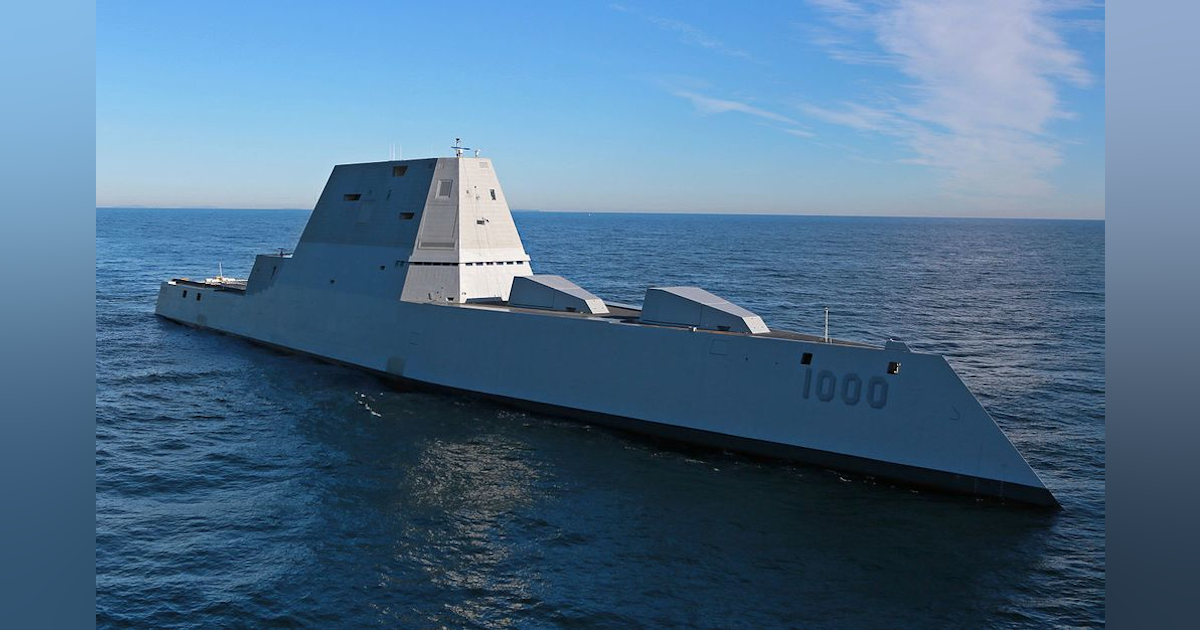The third and the final of the US’ Zumwalt-class (DDG-1000) stealth destroyers, the Lyndon B. Johnson, completed her ‘builders trials’ (or harbor trials as it is called in India) at the General Dynamics Bath Iron Works in Maine this week.
- India’s ‘White Elephant’: Why Is Indian Army Acquiring Bulky Arjun Tanks To Battle China In High-Altitude Ladakh
- After J-20 Mighty Dragon, China Introduces WZ-7 ‘Soaring Dragon’ Meant To Keep A Hawk-Eye On Indian Troops
It will finally join service in mid-2024, after a full two-year delay. The highly troubled project saw cost overruns, delays, and technical problems finally leading to the watering down of many of its features.
The F-22 of warships, the Zumwalt is revolutionary in many respects, primarily being the world’s full stealth warship, whose Radar Cross Section (RCS) is as small as a small fishing trawler. It achieves this through a combination of radar reflecting surfaces, paint, and electromagnetic emissions.
A High-Tech Ship
The 16,000-ton ship will see finalization of her basic hull, mechanical and electrical systems before heading to the Huntington Ingalls Shipbuilding in Mississippi. This is a departure from how Zumwalt and USS Michael Monsoor were completed, where the complete installation and testing of the ship’s air search radar, vertical launch missile cells, combat system, and commissioning took place at Bath.
This will make space for the ongoing modernization of the US Navy’s existing Arleigh Burke-class destroyers which are being upgraded with the Flight III version of the Aegis combat system.

Its signature Integrated Power System (IPS) generates electricity from the rotating turbines and distributes them across the ship not with mechanical linkages, but electric motors.
Producing a whopping 78 megawatts, it can power 10,000 average American homes. It is hoped to power electricity-guzzling Directed Energy Weapons (DEW) like lasers or insanely-powerful Electromagnetic Rail Guns in the future.
US Air Force Confirms It’s Bringing World’s First Stealth Fighter Aircraft ‘Back In Action’
Its distinct wave-piercing hull shaped in what is called a ‘tumblehome’ design makes it look like a warship straight out of a sci-fi movie. The sides slope inwards, rather than the outward shape of even current warships still being launched. Its two devastating Advanced Gun System (AGS) units are capable of firing a variety of GPS-guided and rocket-assisted rounds.
#Destroyer USS #ZUMWALT DDG1000 launched an SM-2 #Standard #Missile for the first time 13 Oct. The shoot from the ship's unique Mark 57 vertical launch system took place on the Navy's test range off Point Mugu California pic.twitter.com/Ls98FH80HB
— Chris Cavas (@CavasShips) October 19, 2020
The 155 mm gun systems hold 304 rounds in a magazine, capable of firing 10 rounds a minute. The Zumwalt was meant to introduce naval gunfire/naval artillery support – a practice that died with the retirement of the Iowa class battleships – for littoral or amphibious operations by Special Forces deployed through small boats.
Cost Overruns And Delays
But the Zumwalt program has given the US Navy and the Department of Defense (DoD) enough reasons for regret, and it is not just the $4 billion price tag or the $10 billion in development costs.
For one, its trademark, ‘tumblehome’ hull is feared to be unstable with the possibility of tipping over if a wave hits the ship under the right sea conditions, the right angle, and the right speed.
The first-of-its-kind IPS has been found to have severe problems with its software, causing several operational issues. The radar-evading structure – stealth no doubt – has been still been found to be vulnerable to, ironically, lower-frequency S-band radars.
Japan’s 6th-Gen Fighter Jet: After US’ Lockheed & Northrop, Tokyo Now Looks To Join UK-Led Tempest Program
If not an old-school radar system, technologically proficient militaries with sufficiently networked assets, battlefield management systems, sensor fusion, and data sharing can eventually find a roundabout, complicated tricks to detect stealth.
Russia and China also boast advanced systems and technologies and won’t be completely vulnerable to such platforms. In November 2016, the US Navy announced it won’t spend an astronomical $800,000 per round for the AGS, leaving the two units deadweight. In other words, its guns simply won’t have ammunition to fire!
Most astonishingly, the ship lacks a Close-In Weapons System (CIWS), that can’t protect it from salvos of anti-ship missiles. Even the 57 mm Mark-110 cannons that were originally planned on the Zumwalt had only limited CIWS capability, without the reliability of the 20 mm Phalanx Gatling gun or the Rolling Airframe Missile and SeaRAM point Missile Defence Systems.
The cannons were dropped from the Zumwalt’s basic design in 2014 to not add to its radar signature!
Since it does not have Aegis radar and fire control systems, neither will it have capable ‘layered air defense’ systems that can fire advanced Standard Missile 2/3/6 series surface-to-air missiles, that are even Anti-Satellite and Ballistic Missile Defence (BMD) capable! All it has is the RIM-162 Evolved Sea Sparrow Missile, which can’t fly longer than 30 miles.
VIRAL Again: Mid-Air Collision Caught On Camera As Pilot, Passengers Jump-Off The Aircraft
Ironically the Zumwalt program was meant to operate in a “high-threat” environment to support land bombardment, which can’t be achieved without being inherently air defense-capable. Worse, even its intended radar system was downgraded to save costs, where the smaller SPY-3 radar was installed without the SPY-4.
This led to SPY-3 merely being updated with new software to perform both surveillance and tracking roles.
In April this year, Chief of Naval Operations Admiral Mike Gilday said the USN plans fielding hypersonic missiles on the Zumwalt-class destroyers “as an important move forward to turn that into a strike platform”.
This marked even the basic doctrinal orientation of the ship changing from a littoral and amphibious operations support vessel, to a blue-water capable strike platform.
- Parth Satam is a Mumbai-based journalist who has been covering India’s defense sector for more than a decade. He maintains a keen interest in defense, aerospace and foreign affairs and can be reached at satamp@gmail.com
- Follow EurAsian Times on Google News